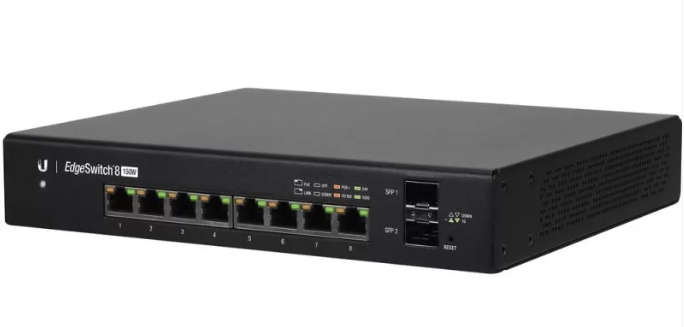Recently, Ubiquiti Network Switch is of prevalence for building and expanding home network. EdgeSwitch and Unifi Switch are two main switch series of the Ubiquiti Network Switch. For years, the EdgeSwitch and Unifi Switch are featured as cost-effective, robust performance, and this is why many people have special favor on them. For they both a good choice for growing networks, it is necessary to make clear their differences and decide which one to choose. In this article, we will mainly introduce the EdgeSwitch vs Unifi Switch, similarities and differences as well as compatible SFP transceivers for them.

Figure 1: This picture shows Unifi Switch US-8-150W(Resource: www.Ubiquiti.com)
Introduction to Unifi Switch
The Unifi Switches provide 8, 16, 24, or 48 PoE Gigabit Ethernet ports to satisfy different requirement for expanding Gigabit Ethernet network and making your network cabling looks neat. They support IEEE 802.3af and IEEE 802.3at. And the operation is rather easy, you can directly connect your switch to a storage server through two SFP ports on each switch. The transmission rate can be up to 1 Gbps. For longer distance and higher bandwidth, you can use Unifi Switch with 48-port which additional added two more SFP+ port.
Information About EdgeSwitch
As same as Unifi Switch, the EdgeSwitch has the same PoE Gigabit Ethernet ports and IEEE protocols. The most distinctive feature of Edgeswitch is that offers an extensive suite of advanced Layer-2 switching features and protocols, and also provides Layer-3 routing capability. There are 6 EdgeSwitch models, the accurate ports’ number are clearly shown in the below chart. You can use ES-8-150W, ES-16-150W and ES-24-250W as well as ES-24-500W switch models to achieve 1G Ethernet network connectivity. SFP+ transceivers, you can choose ES-48-500W, ES-48-750W to arrive 10 Gbps connection.

Figure 2: This picture shows Unifi EdgeSwitch(Resource: www.Ubiquiti.com)
Similarities Between EdgeSwitch vs Unifi Switch
Both Unifi Switch and EdgeSwitch have 8, 16, 24, or 48 PoE Gigabit Ethernet ports.
As for edgeswitch vs unifi switch, the two switches basically share the identical switch type (switch ports and Watts), the only difference lies in the EdgeSwitch does not have one with 8 ports for 60W.
The Unifi Switch and EdgeSwitch both support IEEE 802.3af and IEEE 802.3at.
They both support 1G and 10G Ethernet connections and have both SFP and SFP+ ports.
Differences Between EdgeSwitch vs Unifi Switch
—Color
The EdgeSwitch is black while the Unifi Switch is silver.
The Unifi Switch can only be managed through the UniFi controller while the EdgeSwitch can only be managed through it’s CLI or web interface.
The EdgeSwitches only support static routing, and there are no routing protocols implemented while Unifi Switches don’t support routing at all.
FS.COM’s Compatible SFP Module for EdgeSwitch vs Unifi Switch:
Multi-mode and single mode SFP models are available for Unifi and Edge switch. FS.COM is a leading manufacturer and supplier of fiber optic subsystems, components and solutions. Our optical modules are well known as the superior quality and high compatibility. Besides, all of our products are tested and 100% compatible with major brands, such as Cisco, Juniper, Brocade, Arista, etc. You can rest assured to use them. For this Unifi and Edge switch, we offer the following compatible SFP module:
1000Base-LX: SFP1G-LX-31 1310nm (Single Mode SFPs).
1000Base-SX: SFP-1G85-5M (multi-mode).
1000Base-T: SFP-GB-GE-T Module.

Figure 3: This picture shows FS SFP Transceiver(Resource: fs.com/uk)
Conclusion
Ubiquiti Network Switch seems to be an irresistible trend for home network connectivity. Through this passage, we learned that EdgeSwitch vs Unifi switch are different in color, management and routing protocols. If you are looking for compatible SFP transceivers for those two kinds of switches, you can give FS.COM a try. In addition to SFP transceivers, we still offer many other optical products, such as patch cables, SFP+, QSFP and QSFP28 optical modules, network cables, switches, etc. If you are interested, you can visit www.fs.com.
Related Article:
Gigabit Switch: Ethernet Switches Recommendations
Managed vs Unmanaged Switch: Which One Can Satisfy Your Real Need?

